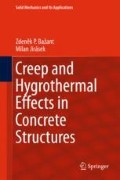Abstract
Despite complexities such as aging due to cement hydration or strong moisture sensitivity, the creep of concrete at service stress levels belongs to the broad realm of linear viscoelasticity, a theory that has been extensively studied beginning with the works of Maxwell, Kelvin, and Boltzmann in the late nineteenth century. Thanks to linearity, we introduce the compliance function as the basic material characteristic for constant sustained stress. Then we use the principle of superposition to characterize the creep at variable stress, calculate the relaxation function for constant imposed strain, and generalize the creep model to multiaxial stress. Finally we introduce an operator notation, which simplifies the mathematical exposition and illuminates the main concepts.
Notes
- 1.
The value of Heaviside function at \(s=0\) is often defined as 1/2, for symmetry reasons. For the present purpose, it is preferable to set \(H(0)=1\).
- 2.
Here, we consider only the mechanical strain, i.e., the stress-induced part of deformation. Of course, in general one needs to account for other sources of deformation, such as thermal changes or shrinkage, which will be incorporated in Sect. 2.5.
- 3.
What exactly is meant by “instantaneous” strain depends on the time scale at which we work. It is hard to make a clear distinction between the truly instantaneous strain and the part of creep that takes place very shortly after loading.
- 4.
Concrete creep tests are typically performed under compression, and the resulting creep strains are thus negative. For simplicity, the negative sign is sometimes omitted in graphical representations of the results, e.g., in Fig. 2.2a, but the sign must be included in all calculations. Of course, the compliance is always positive, no matter whether it is determined from a compressive or a tensile test.
- 5.
In integral expressions similar to (2.14), t is called the current time, \(t'\) is the historic time, and \(t-t'\) is the elapsed time. In mathematical terms, the compliance function J is called the kernel of the integral transform mapping the stress rate onto the strain. For nonaging materials, \(J(t, t')\) is replaced by \(J_0(t-t')\), called the convolution kernel, and the integral in (2.14) represents the convolution of the compliance function and the stress rate.
- 6.
It is interesting to note that (2.16) is a Volterra equation of the first kind, with the stress rate as the unknown function and the compliance function as the kernel of the integral operator, while (2.21) is a Volterra equation of the second kind, with the stress as the unknown function and the stress impulse memory function as the kernel.
- 7.
Analytical solutions exist for nonaging materials with compliance functions corresponding to rheologic chains, but for chains consisting of many units they are usually very complicated.
- 8.
This assumption would not be realistic at young ages, when the material evolves from a liquid (fresh concrete mix) to a solid (hardened concrete) and Poisson’s ratio decreases from initial values near 0.5 to final values near 0.2.
- 9.
In this book, whenever an operator is applied on a function of several variables, it is supposed that it acts on variable t, and the other variables are considered as parameters. In some rare cases, it will be necessary to let an operator act on variable \(t'\), and this will be emphasized by denoting the operator as \({\mathscr {J}}'\) or \({\mathscr {R}}'\) instead of \({\mathscr {J}}\) or \({\mathscr {R}}\).
Author information
Authors and Affiliations
Corresponding author
Rights and permissions
Copyright information
© 2018 Springer Science+Business Media B.V.
About this chapter
Cite this chapter
Bažant, Z.P., Jirásek, M. (2018). Fundamentals of Linear Viscoelasticity. In: Creep and Hygrothermal Effects in Concrete Structures. Solid Mechanics and Its Applications, vol 225. Springer, Dordrecht. https://doi.org/10.1007/978-94-024-1138-6_2
Download citation
DOI: https://doi.org/10.1007/978-94-024-1138-6_2
Published:
Publisher Name: Springer, Dordrecht
Print ISBN: 978-94-024-1136-2
Online ISBN: 978-94-024-1138-6
eBook Packages: EngineeringEngineering (R0)

